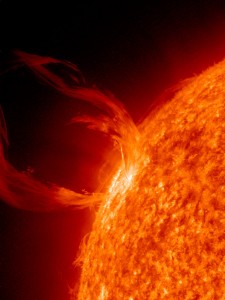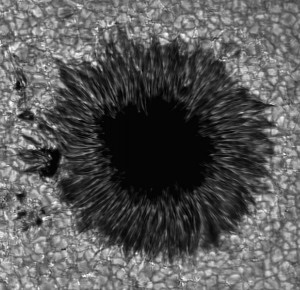Is the solar cycle shutting down?
 New results indicate it may very well be, at least temporarily. Even though the Sun is currently approaching the peak of its cycle in 2013, and we’re seeing an increase in activity (more sunspots, flares, and other violent events), there are strong signs that the next expected peak (in 2022 or later) may be weaker, or may not come at all!
New results indicate it may very well be, at least temporarily. Even though the Sun is currently approaching the peak of its cycle in 2013, and we’re seeing an increase in activity (more sunspots, flares, and other violent events), there are strong signs that the next expected peak (in 2022 or later) may be weaker, or may not come at all!
Here’s the deal. The Sun is a seething ball of ionized gas, called plasma, and has very complex magnetic fields that interact with this plasma. The overall strength and activity from the magnetic field rises and falls on roughly an 11 year cycle. When the cycle is at its minimum the field strength is weak, and we see few or no sunspots or other activity. Then, a little over five years later, the cycle peaks and there’s lots of fun stuff going on, with flares, coronal mass ejections, and more.
Scientists studying the Sun have been trying to figure out this cycle for over a century. It’s very complex, but as technology has gotten better, some trends have been found. And recently, these indicators are all pointing to the Sun settling down magnetically.
For one, there is an east/west river of gas the flows under the surface of the Sun (it can’t be seen directly, but it generates sound waves that travel from it to the surface, revealing its presence; I describe this in detail in an earlier post). This river comes and goes, but usually forms at mid-latitudes on the Sun and shifts toward the equator as the cycle progresses. As it does so, sunspots form above it. Although the next cycle won’t start for a few years, the river associated with it should already be forming. However, there are no indications it has, making astronomers think the next cycle may be delayed.
 For another, scientists have found that the average magnetic strength of sunspots has been declining over the years. Sunspots form when magnetic fields inside the Sun break through the surface. Normally, rising gas from the solar interior would cool and drop back down, but due to the way the magnetic fields interact with the gas, the cool gas is prevented from dropping. Cooler gas is dimmer, so we see this as dark spots on the Sun: sunspots.
For another, scientists have found that the average magnetic strength of sunspots has been declining over the years. Sunspots form when magnetic fields inside the Sun break through the surface. Normally, rising gas from the solar interior would cool and drop back down, but due to the way the magnetic fields interact with the gas, the cool gas is prevented from dropping. Cooler gas is dimmer, so we see this as dark spots on the Sun: sunspots.
Sunspots are an intrinsically magnetic phenomenon, so this trend of weaker magnetic fields inside them may be indicating, again, the next cycle may be delayed or not come at all.
Moving farther outward yet we come to the third line of evidence of a weak upcoming cycle. The Sun has an atmosphere, called the corona, of very thin but extremely hot plasma. It too is greatly affected by magnetic fields; every cycle the magnetic activity in the corona tends to form near the Sun’s equator and then slowly move toward the poles over the next few years. This “rush to the poles”, as the scientists call it, is very weak this year, and may indicate that the peak in 2013 may not be terribly active. It’s unclear what this might mean for the cycle peak after that.
So what does this mean for us? Well, it’s hard to say. In some sense this may be good news; when the Sun is active it tends to have violent explosions like flares and coronal mass ejections, and these can damage our satellites or even cause power blackouts on Earth. A weaker cycle means less chance of that. Yay!
However (isn’t there always a “however”?), back in the late 17th and early 18th centuries, there was a crippling cold snap in Europe called the Little Ice Age, and it coincided with a time of almost no sunspots or other solar activity (called the Maunder Minimum). The connection still isn’t all that clear – for example, North America had climate issues too, but not as severe as Europe, and while the winters in Europe were terrible, the summers weren’t all that much cooler. Apparently there were other factors, including volcanic eruptions and an unusually weak jet stream (which is affected by ozone production in the Earth’s upper atmosphere, which in turn was lowered due to lower solar activity!), amplifying this effect. You can read about this in detail in my book Death from the Skies!
Mind you, these indicators don’t say much about the long-term magnetic health of the Sun; only that we may experience a weak peak in 2013 and a weaker or delayed peak the time around. After that, who knows?
Also, it seems very unlikely to me that we might experience another global cooling period due to this weakened sunspot cycle, but it shows you that there are very sensitive effects going on here that are very difficult to predict – and let me take this chance here to say that no, the Sun is not responsible for global warming, as has been shown fairly conclusively. It can mildly amplify or suppress such things, but is not the main driver of it. If it were, we’d see very strong correlations between the climate and solar activity on a decade-by-decade basis (or even shorter as sunspots form and dissipate over the course of days and weeks). We don’t, and therefore the Sun is not the culprit.
The point is the Sun is a complex beast, and it’s only just now that we are able to make any predictions about it at all. Even this one is not a sure thing, though I’ll admit the fact that three different lines of evidence point toward a weaker cycle are very interesting to say the least! I do hope they’re correct, actually. Not because I want to see one particular outcome or another from the next cycle, but because if these predictions do pan out it means we are beginning to understand the fiendishly complicated physics of our nearest star. Any time we can do that it means we can be prepared if it does decide to do something nasty.
Credit: NASA/SDO/AIA; IBIS/Richard B. Dunn Solar Telescope
Related posts:
- Is global warming solar induced?
- Here comes the Sun(spot)!
- The Sun blasts out a flare and a huge filament
- The Sun lets loose a HUGE explosion